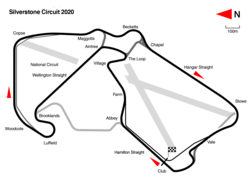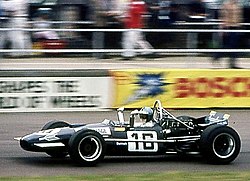Silverstone Circuit
Silverstone Circuit is an English motor racing circuit next to the Northamptonshire villages of Silverstone and Whittlebury. Nearly half of the circuit is across the Northamptonshire boundary in Buckinghamshire. The closest large towns are Northampton and Milton Keynes. It is best known as the home of the British Grand Prix, which it first hosted in 1948 and which has been held on the circuit every year since 1987. The circuit is also home to the BRDC International Trophy, awarded to the winner of a race for historic F1 cars at the annual Silverstone Classic meeting.
| "Home of British Motor Racing"[1] | ||
|---|---|---|
 | ||
| Silverstone Circuit - 2010 Onwards | ||
| Location | Silverstone, Northamptonshire, England | |
| Time zone | GMT | |
| Coordinates | 52°4′43″N 1°1′1″W / 52.07861°N 1.01694°WCoordinates: 52°4′43″N 1°1′1″W / 52.07861°N 1.01694°W | |
| Major Events | FIA Formula One British Grand Prix FIM MotoGP British Grand Prix FIM Superbike World Championship FIA GT1 World Championship Le Mans Series | |
| Arena Grand Prix Circuit[2] | ||
| Circuit Length | 5.901 km (3.667 mi) | |
| Turns | 18 | |
| Lap Record | 1:30.874 ( | |
| Bridge Grand Prix Circuit | ||
| Circuit Length | 5.141 km (3.194 mi) | |
| Turns | 17 | |
| Lap Record | 1:18.739 ( | |
| International Circuit | ||
| Circuit Length | 3.619 km (2.249 mi) | |
| Turns | 10 | |
| National Circuit | ||
| Circuit Length | 2.638 km (1.639 mi) | |
| Turns | 6 | |
| Stowe Circuit | ||
| Circuit Length | 1.281 km (0.796 mi) | |
| Turns | 5 | |
Circuit development
Silverstone Circuit is built on the site of RAF Silverstone, a World War II Royal Air Force bomber station. RAF Silverstone opened in 1943.
Silverstone was first used for racing by a group of friends who set up their own race in September 1947. Maurice Geoghegan, lived in Silverstone village and was knew that the airfield was deserted. He and eleven other drivers raced over a two-mile circuit. Geoghegan's car ran over a sheep and killed it. The car was beyond repair. This informal race became known as the Mutton Grand Prix.[3]
The next year the Royal Automobile Club leased the airfield and set-up a more formal racing circuit. Their first two races were held on the runways, with long straights and tight hairpin corners. For 1948, it was decided to switch to the perimeter track. This arrangement was used for the 1950 and 1951 British Grands Prix. Several small changes were made in the track before the track underwent a major redesign after the 1990 race.
Following the deaths of Ayrton Senna and Roland Ratzenberger at the 1994 San Marino Grand Prix, many Grand Prix circuits were modified in order to reduce speed and increase driver safety. The entry from Hangar Straight into Stowe Corner was modified in 1995 so as to make its entry less dangerous and less challenging. The high speed Abbey kink was changed to a chicane in just 19 days before the 1994 Grand Prix.
Spectator traffic management
Silverstone has suffered with bad traffic delays on race days. The traffic problem was improved when the A43 Silverstone bypass was built. When the race date was moved to April in 2000] heavy rain turned the fields used for parking into mud pits, causing severe problems for the spectators trying to park.[4] On F1 race day many spectators travel to the circuit by helicopter. Silverstone Heliport is the busiest airport in the UK for this day.[5]
+{{{1}}}−{{{2}}}
Hosting Grands Prix and Formula One
Silverstone is the current home of the British Grand Prix, which it first hosted in 1948. The 1950 British Grand Prix at Silverstone was the first race in the newly created Formula One World Championship. The race rotated between Silverstone, Aintree and Brands Hatch from 1955 to 1986. In 1987 the rotation stopped and the race stayed at Silverstone.
In 2004, Silverstone was in danger of losing the Grand Prix. There was even the possibility that the British Grand Prix would not be run in 2005.[6] In December an agreement was reached with Formula One Silverstone would host the British Grand Prix until 2009. Starting in 2010 Donington Park would become the new host of the British Grand Prix. Then the Donington Park leaseholders ran into economic problems. A new deal with Formula One resulted in a 17-year deal to hold the British Grand Prix at Silverstone.[7]
Other competitions
The Dunlop MSA British Touring Car Championship withdrew the track from its calendar in 2007. Strong demand brought the series back to Silverstone for the 2008 BTCC calendar. Silverstone also hosts rounds of the FIA GT, British Superbikes, British F3, British GT and Le Mans Series championships as well as many club racing series. It is also host to the UK's only 24-hour car race, the Britcar 24, which is gaining in popularity, having first started in 2005.
It has in the past hosted exhibition rounds of the D1 Grand Prix both in 2005 and 2006. The course makes use of both Brooklands and Luffield corners to form an S-bend – a requirement in drifting. The section is currently used to host a European Drift Championship round. The Course also hosts the Formula Student Competition by the iMeche yearly.
In 2010 Silverstone hosted its very first Superleague Formula event.[8]
Redevelopment for motorcycle racing
Both the FIM and Silverstone agree the circuit needs to be remodeled for motorcycle racing. The riders are concerned over the closeness of the bridge at Bridge corner.[9]
On 22 January 2010 it was confirmed that Silverstone would host the British round of the 2010 Superbike World Championship season. The race was moved after Donington Park was deemed "un-raceable".[10]
Current circuit configurations
Like most racing circuits around the world, the Silverstone Circuit has a number of different layouts. The layouts offer different lengths and complexity.
New Grand Prix Circuit: Length: 5.9 km. Also known as the 'Arena Layout' Takes over as the primary circuit from 2010. Used for the British Grand Prix and MotoGP from 2010 onwards.
Bridge Grand Prix Circuit: Length: 5.14 km. Before 2010 known as just 'Grand Prix Circuit'. Last modified in 2000, used for the British Grand Prix up to 2009.
Previous configurations
The original 1948 circuit, using the main and second runways. Lap record: Luigi Villoresi, Maserati, 2:52.0 1948 British Grand Prix)
1949 to 1951 Lap record: José Froilán González, Ferrari, 1:43.4 (1951 British Grand Prix)
1952 to 1973: following the move of the pit area. Lap record: Ronnie Peterson, Lotus-Ford, 1:16.3 (1973 British Grand Prix)
1975 to 1986: with the Woodcote Chicane in place to reduce speeds through Woodcote Corner. Lap record: Keke Rosberg, Williams-Honda, 1:05.591 (1985 British Grand Prix)
1987 to 1990: with the Bridge Chicane in place to reduce speeds through Woodcote Corner. Lap record: Nelson Piquet, Williams-Honda, 1:07.110 (1987 British Grand Prix)
1991 to 1993: with every corner except for Woodcote & Abbey redesigned. Using the new Becketts, Vale, Priory and Luffield corner complexes and elevation changes throughout the track. Lap record: Nigel Mansell, Williams- Renault, 1:18.965 (1992 British Grand Prix)
1994 and 1995: with the addition of the Abbey Chicane. Lap record: Damon Hill, Williams- Renault, 1:24.960 (1994 British Grand Prix)
1996: with minor adjustments to the Stowe and Club corners. Lap record: Damon Hill, Williams-Renault, 1:26.875 (1996 British Grand Prix)
1997 to 1999: with further changes to the Vale complex. Lap record: Jacques Villeneuve, Williams-Renault, 1:21.598 (1997 British Grand Prix)
2000 to 2009: with the reprofiled Luffield complex reduced to one corner. Lap record: Michael Schumacher, Ferrari, 1:18.739, (2004 British Grand Prix)
Silverstone Circuit Media
Piers Courage on his way to 5th place in the 1969 British Grand Prix, aboard Frank Williams Racing Cars's Brabham-Cosworth BT26A
Niki Lauda taking the Ferrari 312T through Maggotts Copse during 1975 John Player Grand Prix, Silverstone
Jochen Mass (Martini Racing Porsche 935) during the 1976 Silverstone Six-Hours
John Watson's 1981 British Grand Prix race winning McLaren, during the 2011 Silverstone Classic meeting
Keke Rosberg driving the Williams FW10 at the 1985 German Grand Prix. Rosberg lapped Silverstone at over 160 mph (260 km/h), during qualifying for the 1985 British Grand Prix
Nigel Mansell gives Ayrton Senna a lift back to the pits on the side-pod of his Williams FW14.
Johnny Herbert winning the 1995 British Grand Prix, driving the Benetton-Renault B195
References
- ↑ "BTCC heading for the Home of British Motor Racing | Racecar - Motorsport News". Racecar. 2009-08-13. Archived from the original on 2016-03-14. Retrieved 2010-07-05.
- ↑ "New Silverstone circuit gets green light for 2010 British Grand Prix". Silverstone Circuit (British Racing Drivers' Club). 2010-02-11. http://www.silverstone.co.uk/news/latest-news/New-Silverstone-circuit-gets-green-light-for-2010-British-Grand-Prix/. Retrieved 2010-02-11.
- ↑ Tibballs, Geoff (2001). Motor Racing's Strangest Races. London: Robson Books. pp. 123–124. ISBN 9781861054111.
- ↑ "Silverstone warned over washout (BBC)". BBC News. 2000-06-21. Retrieved 2010-07-05.
- ↑ "Guardian Silverstone track guide". Sport.guardian.co.uk. 10 March 2008. Retrieved 2010-07-05.
- ↑ "British GP set for axe". Itv-f1.com. Archived from the original on 2005-03-24. Retrieved 2010-07-05.
- ↑ "news.bbc.co.uk Silverstone seals British GP deal". BBC News. 2004-12-09. Retrieved 2010-07-05.
- ↑ "12 races on the 2010 Superleague Formula by Sonangol schedule / News archive / News & Media / Home". Superleague Formula. Archived from the original on 2010-01-15. Retrieved 2010-07-05.
- ↑ Stoner welcomes Silverstone switch. Insidebikes. http://www.carolenash.com/insidebikes/bike-sport/stoner-welcomes-silverstone-switch.htm. Retrieved 2010-01-26.
- ↑ Silverstone gets British WSB. Insidebikes. http://www.carolenash.com/insidebikes/bike-news/silverstone-gets-british-wsb.htm. Retrieved 2010-01-26.
Other websites
| Wikimedia Commons has media related to Lua error in Module:Commons_link at line 62: attempt to index field 'wikibase' (a nil value).. |
























